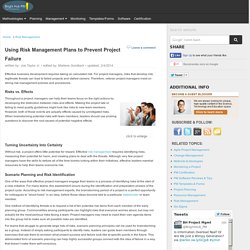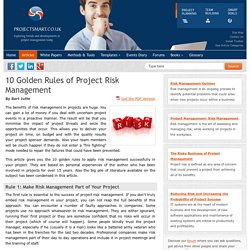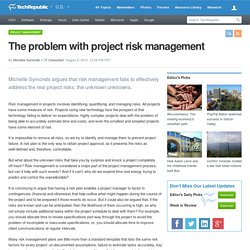

FMEA: A Fantastic Risk Management Tool Including Worksheet. Written by: SparkKD • edited by: Marlene Gundlach • updated: 3/23/2013 This article explains the concept of FMEA (Failure Modes & Effects Analysis) and its application as a risk management tool in projects.

Risk Management is a key component in a project manager’s job and he/she has to make use of various Risk Management Tools. Risk Management: Planning Ahead and Preventing Project Failure. Written by: Joe Taylor Jr. • edited by: Marlene Gundlach • updated: 2/4/2014 Effective business development requires taking on calculated risk.

For project managers, risks that develop into legitimate threats can lead to failed projects and stalled careers. Therefore, veteran project managers insist on strong risk management policies and procedures. Risks vs. Effects Throughout a project, managers can help their teams focus on the right actions by developing the distinction between risks and effects. Risk management. Risk management is the identification, assessment, and prioritization of risks (defined in ISO 31000 as the effect of uncertainty on objectives) followed by coordinated and economical application of resources to minimize, monitor, and control the probability and/or impact of unfortunate events[1] or to maximize the realization of opportunities.

The strategies to manage threats (uncertainties with negative consequences) typically include transferring the threat to another party, avoiding the threat, reducing the negative effect or probability of the threat, or even accepting some or all of the potential or actual consequences of a particular threat, and the opposites for opportunities (uncertain future states with benefits). Introduction[edit] A widely used vocabulary for risk management is defined by ISO Guide 73, "Risk management.
Vocabulary. Risk management also faces difficulties in allocating resources. Method[edit] Managing Risks: A New Framework. Editors’ Note: Since this issue of HBR went to press, JP Morgan, whose risk management practices are highlighted in this article, revealed significant trading losses at one of its units.

The authors provide their commentary on this turn of events in their contribution to HBR’s Insight Center on Managing Risky Behavior. When Tony Hayward became CEO of BP, in 2007, he vowed to make safety his top priority. Among the new rules he instituted were the requirements that all employees use lids on coffee cups while walking and refrain from texting while driving. Three years later, on Hayward’s watch, the Deepwater Horizon oil rig exploded in the Gulf of Mexico, causing one of the worst man-made disasters in history. A U.S. investigation commission attributed the disaster to management failures that crippled “the ability of individuals involved to identify the risks they faced and to properly evaluate, communicate, and address them.” Managing Risk: Rules or Dialogue? Category II: Strategy risks. 10 Golden Rules of Project Risk Management.
The benefits of risk management in projects are huge.

You can gain a lot of money if you deal with uncertain project events in a proactive manner. The result will be that you minimise the impact of project threats and seize the opportunities that occur. This allows you to deliver your project on time, on budget and with the quality results your project sponsor demands. Also your team members will be much happier if they do not enter a "fire fighting" mode needed to repair the failures that could have been prevented. The problem with project risk management. Michelle Symonds argues that risk management fails to effectively address the real project risks: the unknown unknowns.

Risk management in projects involves identifying, quantifying, and managing risks. All projects have some measure of risk. Projects using new technology face the prospect of that technology failing to deliver on expectations; highly complex projects deal with the problem of being able to accurately estimate time and costs; and even the smallest and simplest projects have some element of risk.
It is impossible to remove all risks, so we try to identify and manage them to prevent project failure. A risk plan is the only way to obtain project approval, as it presents the risks as well-defined and, therefore, controllable. But what about the unknown risks that take you by surprise and knock a project completely off-track? If we know about potential risks, why are we even calling them risks -- aren't they simply the inherent uncertainties present in doing anything new?